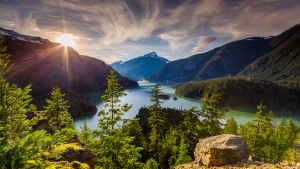Washington's Model Toxics Control Act: Transforming Contaminated Sites into Community and Environmental Assets
The Model Toxics Control Act (MTCA) has been cleaning up contaminated sites in Washington State for 30 years. On December 10, 2019, Beveridge & Diamond and the Environmental Law Institute will be hosting a seminar (MTCA 30) to celebrate the success and examine the future of the state’s cleanup statute with an all-star program featuring some of the state’s leading experts. In advance of the seminar, B&D is publishing a series of articles focused on MTCA.
MTCA's Many Triumphs
MTCA has been spurring the cleanup of contaminated sites in Washington for 30 years. Since MTCA went into effect, over 7,000 sites have been cleaned up. While the workhorse statute is not going to take a rest anytime soon, with more than 6,000 sites requiring further action before closure and over 200 new sites identified each year, the citizen’s initiative already has amassed an impressive legacy. Below are just a few of the many examples where MTCA has been instrumental in turning contaminated properties into productive community and environmental assets – on both large and small scales and in urban and rural areas of Washington.
- Mount Baker Housing Association – Restoring Brownfields to Provide Affordable Housing in Seattle’s Rainier Valley. In 2016, the Mount Baker Housing Association (MBHA) entered into a prospective purchaser consent decree with the State of Washington to investigate and ultimately clean up chlorinated solvent contamination from a former dry cleaner and petroleum contamination from a former gas station and auto repair facility. The innovative use of MTCA’s prospective purchaser provisions allowed the nonprofit affordable housing developer to take on the risks of investing in properties with known contamination while gaining liability protections and expanding housing options for lower-income earners in an expensive real estate market. Importantly, the settlement also has provided a vehicle for MBHA to receive public funds to cover at least some of the remedial action costs. Just the other week, MBHA released a draft remedial investigation / feasibility study and a draft cleanup action plan for public comment.
- Puget Sound Initiative – Ensuring Healthy Habitats in Padilla and Fidalgo Bays. In 2007, the Department of Ecology (Ecology) identified seven bays around Puget Sound where it would prioritize cleaning up contaminated sites and habitat restoration. In Padilla and Fidalgo Bays in northern Puget Sound, six industrial waterfront sites have been cleaned up while work on five other sites is in progress. The bays are home to valuable marine habitat, including extensive eelgrass beds, which serve as groundfish nurseries. The sites that have been cleaned up in the last 15 years include a former oil tank farm, a former lumber mill and pulp mill, a boatyard, and former milling, shipbuilding, and marina operations, among others.
- Kittitas Valley Fire and Rescue – Building a New Fire Station in Ellensburg. When the Kittitas Valley Fire and Rescue was looking for a new fire station location, it purchased a property that had been used for hay scales, as well as truck repair and fueling, with associated soil and groundwater contamination. During property redevelopment, the contamination was investigated and remediated, with assistance from Ecology. With effective planning and use of the building design as a protective cap, cleanup was completed for under $250,000 and in under three months.
- Kendall Yards – Transforming an Old Railyard in Spokane. In 2005, River Front Properties, LLC entered Ecology’s Voluntary Cleanup Program to address contamination at a 78-acre site to the northwest of Spokane’s downtown area. The site had been used extensively for locomotive repair and servicing and had served as a location for plating and storage operations. Over a single year, 200,000 tons of soil contaminated with petroleum, PAHs, and metals were removed from the site. Now, Kendall Yards has turned into a vibrant community with a growing collection of houses, apartment buildings, offices, and restaurants.
- Gas Stations, Dry Cleaners, and Underground Storage Tanks Around the State. Contaminated sites are not caused only by heavy industrial operations. Many of the most common sources of contamination are gas stations, dry cleaners, and other businesses with underground storage tanks. Ecology has identified over 7,000 leaking tanks in the state. But significant progress is being made. Contamination from over 4,000 tanks has been remediated, and cleanup has started for over 2,000 more tanks. For gas stations, Ecology has entered into multi-site agreements to facilitate and coordinate cleanups for parties with larger portfolios of sites. Collectively, efforts to address contamination at service stations and dry cleaners have resulted in about a thousand NFA determinations under MTCA.
- Substantial Public Funding for Cleanups and Related Projects. The 1988 citizens’ initiative resulted in a tax on the “first possession” of hazardous substances in Washington, in addition to MTCA’s cleanup framework. Although the tax revenue has fluctuated due to volatility in oil prices, it generated around $2.2 billion between 1988 and 2017 to support Ecology programs and to fund cleanups and related environmental projects around the state. This funding is critical to remediating sites where sufficient private dollars are not available. For instance, between 2015 and 2017, Ecology provided $1.2 million to remediate American Legion Park in Everett. The park was impacted by the nearby former Asarco smelter. The area-wide cleanup has exceeded the dollars collected in a 2009 bankruptcy settlement with Asarco. This year, the state legislature converted the tax on petroleum products from a price-based tax to a volumetric tax with the goal of making funding more predictable. The Department of Revenue also has estimated that revenues under the new tax will be higher.
For more information about the MTCA 30 seminar on December 10, please contact Gus Winkes, or Alexa Curto.
Beveridge & Diamond’s Superfund, Site Remediation, and Natural Resources Damages practice group assists clients in litigation and allocation of CERCLA sites, including complex, large-scale sites. We counsel clients on developing case law and requirements under CERCLA and state-equivalent hazardous waste laws. For more information, please contact the authors.










